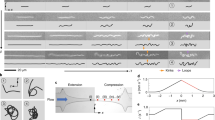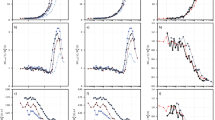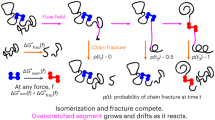Abstract
RIGID, rod-like polymers are of considerable technological importance in the production of high-strength and high-modulus fibres1. Polymerization reactions generally require near-parallel orientation of such molecules, and because of the slow rotational diffusion of the reacting species2, the rate of polymerization is found to decrease significantly in the later stages of the reaction; this ultimately limits the molecular weight of the polymer. It is known, however, that rod-like molecules can be readily oriented in solution by means of imposed flow fields. Here we examine the effect of a shear flow on the polymerization reaction between p-phenylene diamine and terephthaloyl chloride, where the product, poly(p-phenylene terephthalamide), has a rigid, rod-like structure1. We find that once the molecular weight of the reactants exceeds a critical value, shearing of the reaction mixture induces a pronounced orientation of the molecules, accompanied by a significant increase in the polymerization rate. The technological implications are clear: exposure of polymerizing mixtures of rod-like molecules to high shear rates can result in a dramatic enhancement in the molecular weight of the resulting polymer.
This is a preview of subscription content, access via your institution
Access options
Subscribe to this journal
Receive 51 print issues and online access
$199.00 per year
only $3.90 per issue
Buy this article
- Purchase on Springer Link
- Instant access to full article PDF
Prices may be subject to local taxes which are calculated during checkout
Similar content being viewed by others
References
Kwolek, S. L., Morgan, P. W. & Schaefgen, J. R. in Encyclopedia of Polymer Science and Technology (eds Mark, H. F., Bikales, N. M., Overberger, C. G. & Menges, G.) Vol. 9, 1–61 (Wiley, New York, 1987).
Cotts, D. B. & Berry, G. C. Macromolecules 14, 930–934 (1981).
Chella, R. & Ottino, J. M. Arch. Ration. Mech. Anal. 90, 15–42 (1985).
Arpin, M. & Strazielle, C. Polymer 18, 591–598 (1977).
Doi, M. & Edwards, S. F. The Theory of Polymer Dynamics, 324–349 (Clarendon, Oxford, 1986).
Agarwal, U. S. & Khakhar, D. V. J. chem. Phys. 96, 7125–7134 (1992).
Ogata, N., Sanui, K. & Kitayama, S. J. Polym. Sci. Polym. Chem. edn 22, 865–867 (1984).
Takayanagi, M. & Katayose, T. J. Polym. Sci. Polym. Chem. edn, 19, 1138–1145 (1981).
Morgan, P. W. Macromolecules 10, 1381–1390 (1977).
Vollbracht, L. in Comprehensive Polymer Science (eds Allen, G. & Bevington, J. C.) Vol. 5, 375–386 (Pergamon, Oxford, 1989).
Asada, T., Muramatsu, H., Watanabe, R. & Onogi, S. Macromolecules 13, 867–871 (1980).
Author information
Authors and Affiliations
Rights and permissions
About this article
Cite this article
Agarwal, U., Khakhar, D. Enhancement of polymerization rates for rigid rod-like molecules by shearing. Nature 360, 53–55 (1992). https://doi.org/10.1038/360053a0
Received:
Accepted:
Issue Date:
DOI: https://doi.org/10.1038/360053a0
This article is cited by
-
Kinetics Analysis on the Polycondensation Process of Poly(p-phenylene terephthalamide): Experimental Verification and Molecular Simulation
Chinese Journal of Polymer Science (2018)
-
Stable isotopes reveal strong marine and El Niño effects on island food webs
Nature (1999)
Comments
By submitting a comment you agree to abide by our Terms and Community Guidelines. If you find something abusive or that does not comply with our terms or guidelines please flag it as inappropriate.



